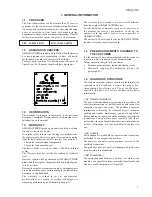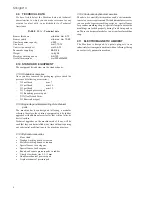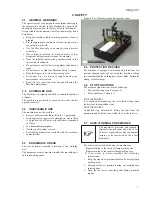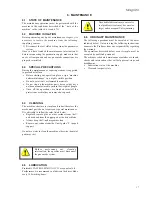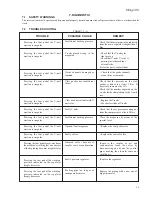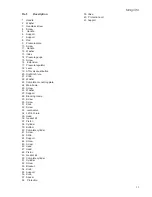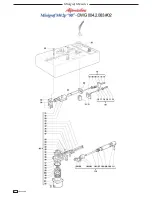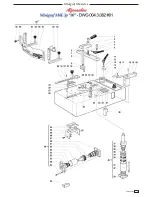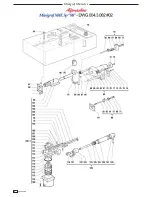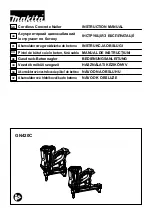
1 5
Minigraf 4
5.2
FUNCTIONING DESCRIPTION
The Minigraf 4 is a 3 position machine. This machine has
been realized for small and medium size production runs.
The machine has only one possible operating mode:
•
Manual functioning using the pneumatic foot pedal
and the pneumatic lever which controls the movement
of the driver assembly.
Pressing the pneumatic foot pedal half way down causes
the clamping of the mouldings.
Pressing the pneumatic foot pedal full down causes it to
drive a v-nail.
The control lever permits the movement of V-nail driver
assembly
•
Pressing the lever half way down causes the driver
assembly to move from the 1
st
to the 2
nd
inserting
position; pressing it all the way down causes it to shift
to the 3
rd
inserting position.
To assemble a corner, operate as follows:
1. Set the insertion position handles
(see chapter 4.9.1)
2. Position the moulding to be assembled on the working
bench
3. Adjust the vertical clamp height and positioning ( see
chapter 4.9.2)
4. Adjust the frontal clamp position
(see chapter 4.9.3)
5. Check & adjust the clamp pressure according to the
hardness of the material to be assembled(see chapter
4.9.5)
5. FUNCTIONING
5.1
OPERATORS
The machine has been projected to be used by only one
operator.
The staff assigned to operate the machine, must be in
possession (or acquire through an adequate training) the
requirements indicated below. In addition they must have
knowledge of this handbook and of every information
concerning safety:
•
General and technical culture sufficient to comprehend
the handbook contents and understand the drawings
and schemes
•
Knowledge of main sanitary, technological and anti-
accidental norms
•
Overall knowledge of the line and plant where the
machine is installed
•
Specific experience in assembling frames
•
To know how to operate the individual protections
devices and how to stop the machine in case of an
emergency
The Maintenance people, in addition to the above
mentioned characteristics, must be in possession of an
adequate technical education.
5.3
TIPS FOR PERFECT JUNCTIONS
a)
V-nail types
In order to allow the machine to make excellent quality
junctions using different materials, it has been necessary
to manufacture different V-nails types for different uses
(see attachment D).
V-nails can be classified in three different groups:
for soft woods and
soft plastic
for medium woods
for hard woods
Suggested V-
nail code
Suggested V-
nail code
Suggested V-
nail code
SW
MW
HW
b) Assembling positions
It is advisable to operate as follows in order to achieve the
best results in terms of junction quality:
Never drive V-nails near the junction vertex. The
minimum recommended distance from the external
vertex is at least 10 mm.
When you want to make the junction using only one V-
nail, the most suitable position is in the middle of the
moulding (see fig. 23)
In case you want to insert 2 or more V-nails into each
junction, we recommend you to insert the most external
one 1/3 from the external vertex and the most internal
one 1/4 from the internal vertex.
6. Press half way down on the foot pedal and verify the
proper positioning and clamping of the mouldings
7. Press the foot pedal full down to insert the V-nail (if the
mouldings profile needs 2 or more V-nails stacked in
the same position, release the foot pedal halfway and
then press it again to insert the 2
nd
V-nail and so on)
8. Release the pedal halfway
9. Press the lateral lever halfway to position the V-nail
ejection group in the next inserting point
10. Press the foot pedal full down to insert
the V-nail (see step 7)
11. Release the pedal halfway
12. Press the lateral lever all the way down
so the driver assembly shifts to the last
insertion point
13. Press the foot pedal full down to insert
the V-nail (see step 7)
14. Release the foot pedal completely to release
the vertical and the frontal clamps.



